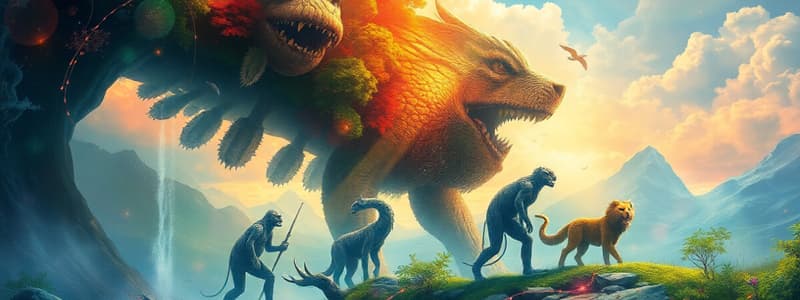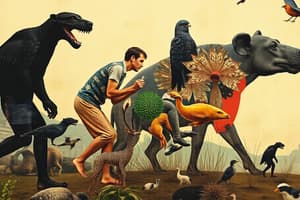Podcast
Questions and Answers
What principle did Lamarck propose regarding traits that are not used by an organism?
What principle did Lamarck propose regarding traits that are not used by an organism?
- They will diminish or disappear. (correct)
- They strengthen and develop over time.
- They are inherited by the next generation.
- They become more favorable for survival.
Which of the following describes Darwin’s theory of evolution by natural selection?
Which of the following describes Darwin’s theory of evolution by natural selection?
- Environmental changes do not affect survival rates.
- Every organism is perfectly adapted to its environment from birth.
- Only individuals with advantageous traits survive and reproduce. (correct)
- All traits are equally beneficial for survival.
How did the finches' beaks provide evidence for evolution?
How did the finches' beaks provide evidence for evolution?
- Beak shape is determined solely by genetics.
- All finches display the same beak shape.
- Different beak shapes arose in response to food resource availability. (correct)
- Finches do not compete for resources in their environment.
Which statement best describes Malthus's influence on Darwin's theory?
Which statement best describes Malthus's influence on Darwin's theory?
What does the term 'survival of the fittest' imply?
What does the term 'survival of the fittest' imply?
Why do fossil studies provide evidence for evolution?
Why do fossil studies provide evidence for evolution?
What observation is related to the concept of overproduction in species?
What observation is related to the concept of overproduction in species?
What role does variation within a population play in evolution?
What role does variation within a population play in evolution?
Flashcards
Lamarck's Use and Disuse
Lamarck's Use and Disuse
Organisms develop traits based on how frequently they are used; unused traits become weaker.
Darwin's Natural Selection
Darwin's Natural Selection
Organisms with traits better suited to their environment are more likely to survive and reproduce.
Malthus' Principle of Population
Malthus' Principle of Population
Populations grow faster than their resources; competition for resources results.
Fossil Evidence of Evolution
Fossil Evidence of Evolution
Signup and view all the flashcards
Overproduction
Overproduction
Signup and view all the flashcards
Natural Selection & Competition
Natural Selection & Competition
Signup and view all the flashcards
Population Variation
Population Variation
Signup and view all the flashcards
Evolutionary Change in Populations
Evolutionary Change in Populations
Signup and view all the flashcards
Study Notes
Evolution and Natural Selection
- Malthus: Populations produce more offspring than resources can support, leading to competition and survival of the fittest.
- Darwin: Species produce more offspring than the environment can support, which results in competition and the extinction of some organisms.
- Wallace: Similar ideas to Darwin, independently.
- Lamarck: Organisms adapt during their lifetime, and these adaptations are passed down to offspring.
- Fossils: Show structural similarities to modern life. "Use and disuse" is a theory of organisms adapting body parts for survival, which are then passed down. Only necessary body parts will be passed to offspring.
Darwin's Principles of Population
- Populations produce more offspring than resources can support.
- Competition exists between organisms for resources.
- Variations exist within populations.
- Organisms with favorable traits for their environment are more likely to survive and reproduce, passing these advantageous traits to their offspring. This is called natural selection.
- The process of natural selection leads to the evolution of species over time.
Additional Points
- Different shaped beaks on birds (finches) are examples of adaptations due to varied food sources.
- Rodents in South America have similar structure to rodents in other continents, demonstrating similarities and differences in species over time.
- Differences in shaped beaks and other traits can be related to specific foods organisms eat.
Studying That Suits You
Use AI to generate personalized quizzes and flashcards to suit your learning preferences.
Description
Test your knowledge on key concepts of evolution and natural selection, focusing on theories by Malthus, Darwin, Wallace, and Lamarck. Explore how fossil evidence supports evolutionary change and the principles governing population dynamics. This quiz covers essential ideas that shape our understanding of biology.



